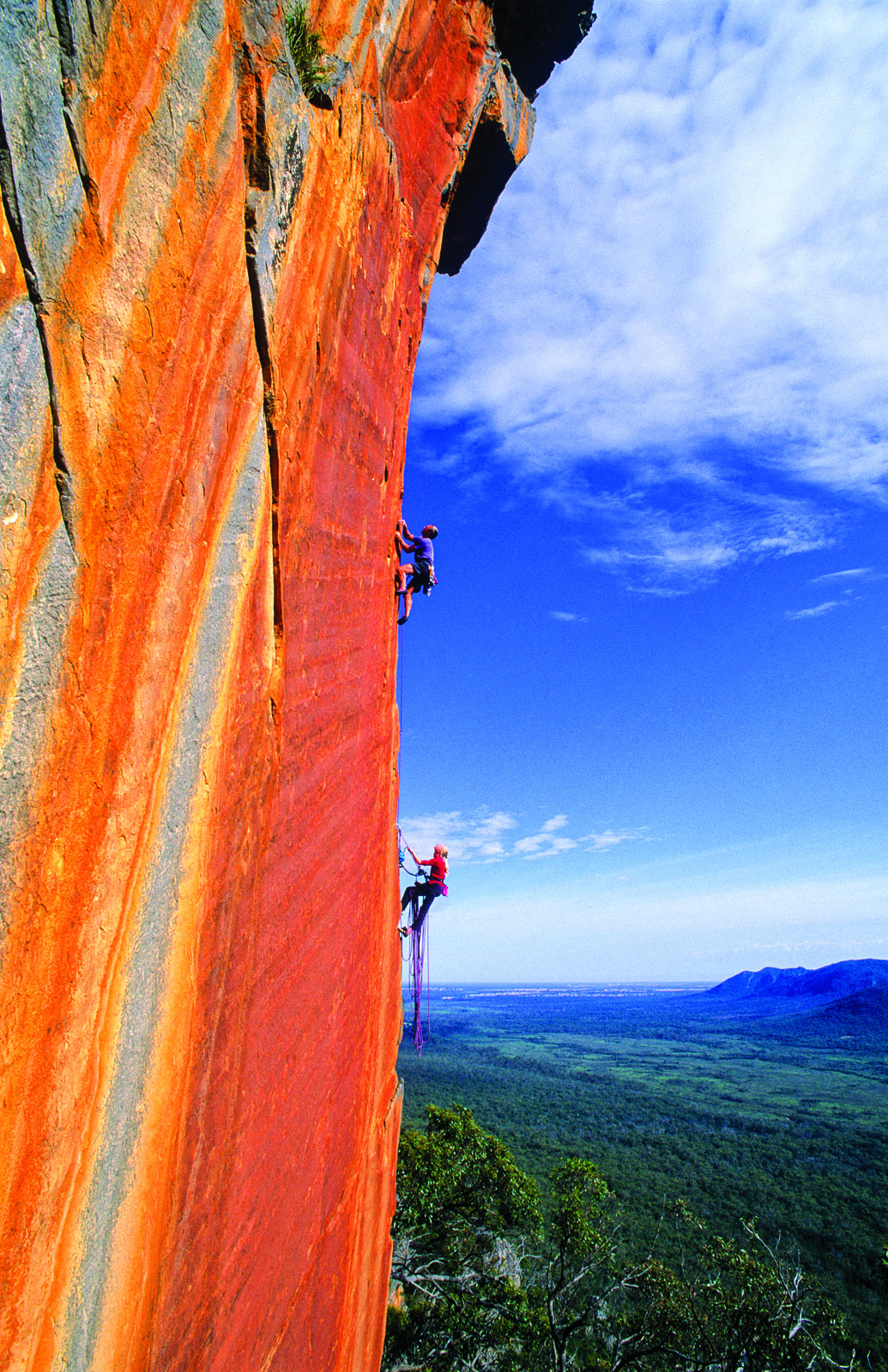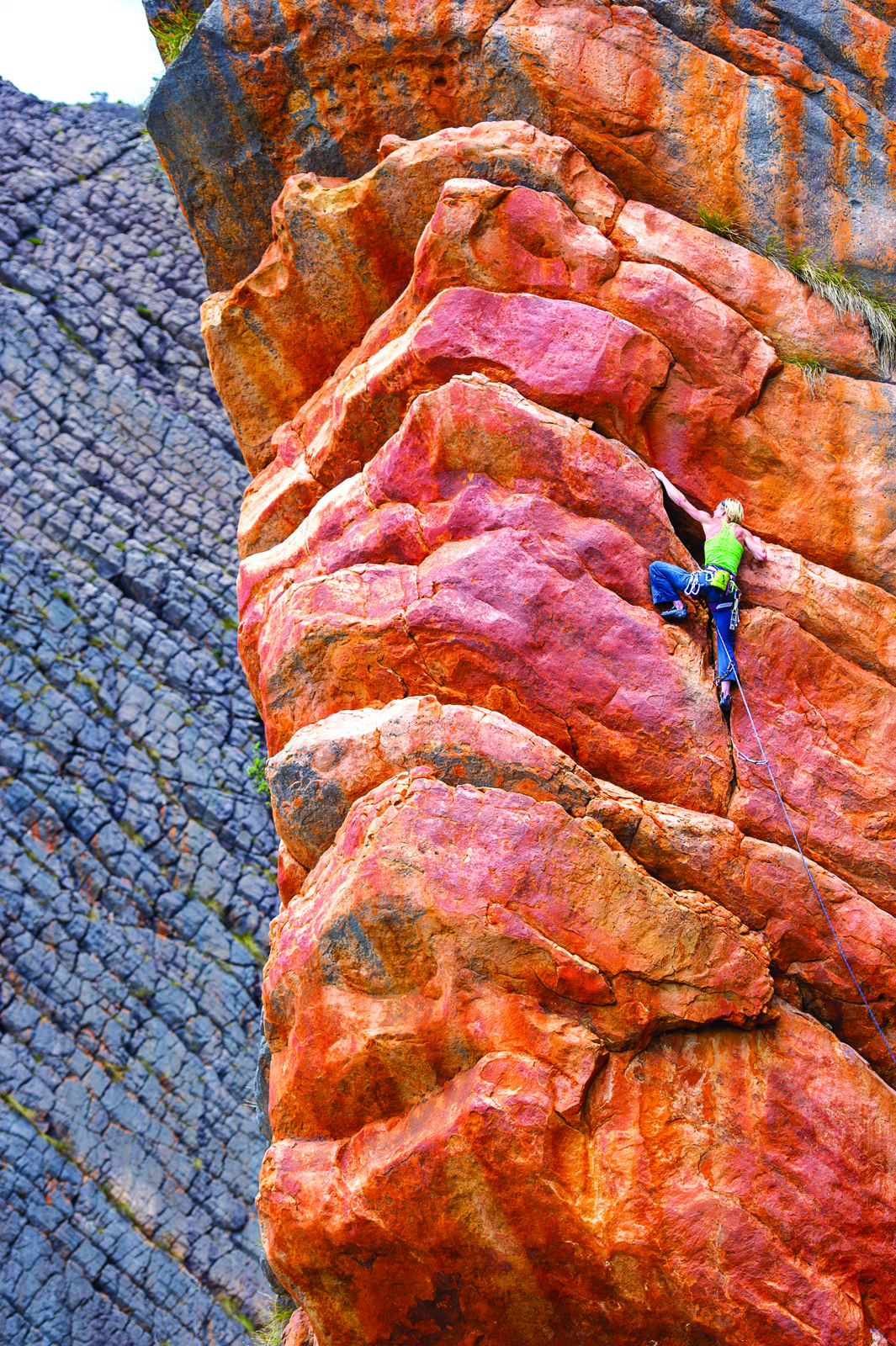Modern rock climbing has been going on in the Grampians for nearly 70 years. Many consider it Australia’s best rock climbing area. It’s also home to a unique environment and many irreplaceable Aboriginal art sites.
The job at hand is to balance the rights of climbers, whilst maintaining minimal environmental impact and preserving Aboriginal cultural heritage.
This job does not need to made so difficult. For example, in the past, if an area became very popular and there was some erosion near a cliff, Parks Victoria and climbers used to work together to solve the problem – one way or another. But now, I feel us climbers are not given the credit we are due. Many climbers are staunch environmentalists; we spend a huge amount of time in the bush and hanging out, literally, in awe-inspiring natural places. A real appreciation, and something of an understanding, does rub off on us. So the interests of climbers, Parks, and Traditional Owners are actually very much aligned.





If the issue of preservation of Aboriginal cultural heritage and climbers comes up, and it has, then surely the best way to approach it is for both parties to sit down together, so we can listen, learn, discuss and ensure the best outcome possible. Perhaps Parks could help facilitate such talks – they know who the parties are. So why is this so hard? Funny how Parks have been able to get their new 144km Three Peaks Trail all approved without any of the same problems that climbers are now faced with. Oh yeah…. Money.
In the Grampians’ near 70 year history of rock climbing, I can’t find one instance of climbers deliberately interfering with or damaging Aboriginal cultural heritage or rock art. I’ve heard of one cliff, which climbers first started going to 25 years ago, where one small piece of almost invisible art was later discovered, located away from the climbs, and to this day this art remains undamaged.
In contrast, the record of land managers is not nearly as good. Around the same time, they drilled and placed a bolt directly into some stunning rock art near Buandik. This bolt was part of a cage intended to protect the art from vandals and ignorant tourists (not climbers), but still, the bolt didn’t need to go there.
Pot. Kettle. Black.
Years later the original cage was removed, a larger cage was installed, and the bolt stud was left there sticking into the rock. This bolt stud has now become rather significant because someone took of photo of it and recently published it on the Parks Victoria website, captioned “bolt-in-rock-art”, as an example of what climbers were allegedly doing in the Grampians.
This would almost be funny except that it is so serious, because the “bolts-in-rock-art” accusation is one of Parks’ cornerstone arguments to justify banning climbing in the Grampians. This complete fabrication may well be affecting decision making at the highest levels, which has led the bans that we have now.
That’s right; on 11 Feb 2019 Parks Victoria announced eight specific areas had been identified where climbing would be banned. 21 further areas are said to be “under review”. But over the last two months the situation has deteriorated significantly; more recently, Parks announced that climbing is now prohibited across all of the “Special Protection Areas”. The SPAs account for 33 per cent of the park by area, but we’ve calculated that roughly 45 per cent of the routes in our Grampians guidebook (the best areas) are affected by the ban.
Parks are now coming up with all sorts of accusations and “justifications” for the bans. Us climbers have been the subject of an ugly smear campaign, painted, to summarise, as chainsaw wielding vandals liable to kill other park users.
Apparently, the Grampians have experienced astronomical “growth of climbing”. Parks Victoria cited some figures to back it up (80,000 climbers per year), but it appears they may have misinterpreted some figures on a website primarily used for logging ascents. Checking the guidebook sales for the last six years since we started, the sales are not going up. The publisher of the main guidebook to nearby Mount Arapiles has reported a downswing, if anything, and his figures go back much further than mine. If there was any significant growth in outdoor climbing, we’d expect to see some significant upswing in sales as well.
Outdoor bouldering might be growing slowly but that would require separate management strategies and is no justification for blanket bans.
Parks also claims an enormous number of new routes and “sites” are being established, saying “The number of climbing sites has risen from approximately 2,000 sites in 2003 to an estimated 8,000 sites in 2018”. Again, this is wrong. I guess you could call a single boulder a “site”, but in recent years the establishment of new routes and areas has actually slowed to a trickle. There are 61 separate “crags” (or cliffs) described in the current guidebook. Since we started the guidebook in 2013, I only know of one “new” crag (Clean Cuts) worth adding (we added this in 2015). The point is, the growth of new “sites” has slowed – the good stuff was found long ago.
There will be some serious implications if these bans become permanent. Business will go bust and there will massive social upheaval; hundreds of climbers live in the area because of the climbing, bringing skills (some are doctors), and boosting the area economically and culturally. As far as management of the park goes, the bans are incredibly counter-productive; they will create a management nightmare.
Plus, they are dangerous. There has not been a rock climbing fatality in the Grampians for many, many years but when you close 45 per cent of the Grampian’s best climbing, you should know that includes some of the safest crags in Victoria; climbers who would have gone to those crags will now have to go somewhere else, perhaps more high risk…
Environmentally, of course, funnelling climbers into fewer areas will only increase any impacts on those. Will climbers then be blamed for that too? The best management response is to keep as many areas as possible open. The Grampians is vast and able to absorb it all, and if any problems are identified then they should be addressed specifically. It’s not too hard; climbers have man/woman power and are keen.
And finally, the big issue of protecting Aboriginal cultural heritage – a climbing ban will not solve anything. It might sound great, but in practical terms it won’t improve anything. Our record is good; very, very good. It doesn’t really require a “solution”, at least not like this. But by banning climbers from these areas you’ve lost our stewardship, our eyes and ears in the bush.
This is just ludicrous. We need people to connect with nature in this world, and climbing happens to be a great way to do it. These bans have been imposed unilaterally, without any consultation with climbers, or transparency. The whole process now lacks credibility in the eyes of many. Apparently, the bans are up for review in the coming weeks – let’s pray a sensible decision is reached and they are completely repealed. Then we can start discussions afresh and get on with all working together as we have in the past.
See www.savegrampiansclimbing.org for more info and the latest.





